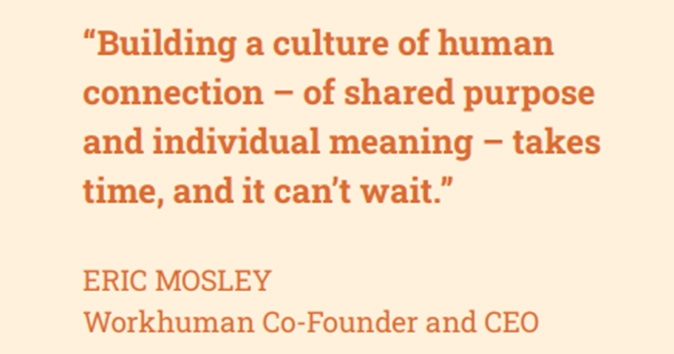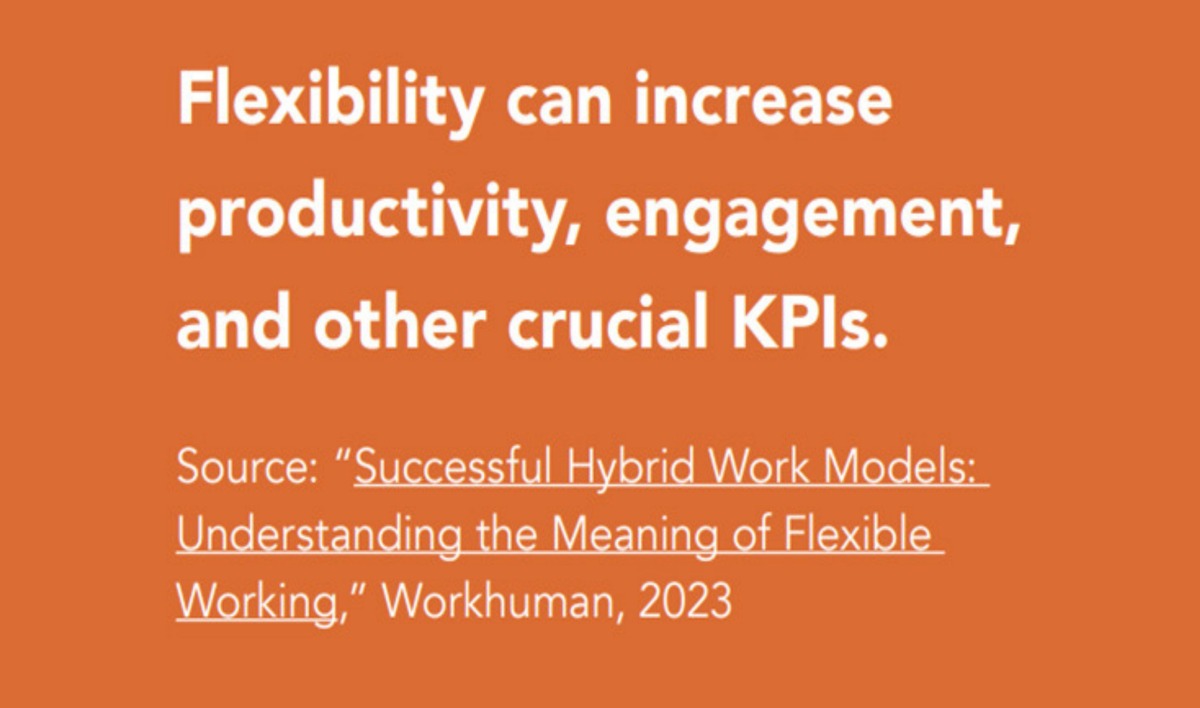5 HR Trends in 2025: Priorities for HRM and the Future of Work

For many companies, December was the time to finalize plans and shift focus to the new year. For us at Workhuman®, it was a time to identify the HR trends that will evolve and emerge in 2025. The goal: prepare leaders for what lies ahead in the workplace.
Research, reports, and pulse surveys throughout the year point once again to the employee experience being the priority. And that will come to life through these leading HR trends in 2025:
- The emergence of AI and its integration into the workplace
- Building company culture through employee wellbeing
- Upskilling and employee development
- Managing an increasingly hybrid and global workforce
- Continuing to embed technology in HR processes
What are the current trends in HR?
The cascading effects of job insecurity, budget constricting, and overall anxiety have been top of mind for employees – and have been for a while now.
Take this as a clear sign that human resource management teams whose goal is to retain employees: Now is not the time to compromise on initiatives designed to improve the employee experience.
The short-term budget relief versus the long-term benefits of continued investment in a people-first culture will define 2025. Here’s how.

2025 HR Trends and Priorities
1. The integration of AI in the workplace
The rise of artificial intelligence (AI) and its integration into HR technology and business processes will be one of the marquee HR trends for 2025. Organizations should strategically incorporate AI into everyday practices, such as recruiting, talent development, and onboarding, but be constantly mindful of how it is integrating with employees.
Organizations can start by dispelling myths and addressing uncertainty. Acknowledge that there are a lot of unknowns surrounding AI while encouraging curiosity and patience in learning especially with folks hesitant to embrace it.
Business leaders and HR professionals can make that learning process engaging by holding contests, challenges, fun training, and recognition programs to familiarize employees with AI and empower them to use it responsibly.
2. Building company culture through employee wellbeing
Our report with Gallup on the state of employee wellbeing, “Amplifying Wellbeing at Work and Beyond Through the Power of Recognition”, unveiled what is at stake when organizations don’t make wellbeing a priority. Unmet employee needs, increased rates of stress and turnover, and massive costs to the company. No one comes out ahead.
The past few years have laid bare the long-buried stresses of the workplace. The need for more dedication to mental health, additional support for working parents, and a shift to a people-first culture is urgent. That’s why it continues to remain one of the highest-priority HR trends.
Recognize and address factors such as trust, work hours, purpose, and recognition contributing to employee well-being and the overall employee experience. There is a strong correlation between employee well-being and better business performance, which makes the investment in well-being initiatives all the more crucial.
Find out how strategic recognition can save your organization more than $90 million in gained employee productivity. Download the Gallup-Workhuman report to see 3 ways recognition improves business outcomes.
Such initiatives include increasing base pay, exploring flexible work arrangements, and providing opportunities for autonomy and recognition.
In 2025, cultures will be strategically designed programs built to validate employees who want to feel like they are part of a winning team and that they are contributing to a successful cause. In this new era of work, some of this will happen in person, and some will happen remotely.
No matter the location, the prevailing truth is that through understanding what inspires employees, companies and HR professionals will be able to make more sound investments in their talent and culture.
The employee experience is largely shaped by the organization’s commitment and success in creating well-being. While so much of it is derived from factors outside the office, employers can still have a significant impact on the organization.

3. Employee Skilling and Upskilling
In response to ongoing hr digital transformation, especially AI, along with changing workforce needs, the need for employee skilling and upskilling is paramount. Upskilling can yield increased productivity, reduced turnover, and a more engaged workforce.
Retaining talent becomes a lot easier when employees see paths to grow within an organization and have the opportunity to refine and expand their skill sets. In fact, our research found that they not only stay longer, they work harder.
According to Gartner, though, 24% of human resources professionals say their leadership development approach “does not prepare leaders for the future of work.”
HR development activities like training in communications, active listening, and problem-solving – that have traditionally been referred to as “soft skills” – will hard-wire a mentality of openness into the work environment. Thus increasing the likelihood of cross-team collaboration, productive working, and stronger manager-employee relationships.
Start by focusing on career growth paths. Provide opportunities for employees to grow vertically and horizontally within the organization by identifying skill gaps and offering relevant training.
Offer skill-based training, mentorship programs, and other development opportunities to support employees in acquiring new skills and advancing their careers.
As none of these trends happen in a vacuum, keep well-being in mind for this initiative. Upskilling initiatives are seen as a solution to prevent burnout, improve productivity, and foster a sense of purpose among employees.
However, increased training on top of their workload could inadvertently contribute to burnout.
Upskilling and employee development opportunities help everyone already on the payroll. For hiring managers, they also serve as an enticing benefit for potential candidates who don’t see the same opportunities at their current employer.
We take this same approach at Workhuman. For example, Filipa, who works on the Supply Chain team, highlights the supportive environment for learning and upskilling, particularly in data analysis, facilitated by her manager and the company.
Here, I discovered my passion for data analysis and the immense value it brings to our team's performance. My manager is so supportive when it comes to me learning more about data analysis and upskilling further. In fact, Workhuman has a fantastic talent development team that offers numerous training courses on an ongoing basis in communication skills, presentation skills, and big rocks, big results amongst just a few!

4. Hybrid Work Models
One of the key HR trends from last year is carrying over to this year, which is hybrid working models. Despite initial return-to-office mandates, remote work remains prevalent, indicating a shift towards hybrid work models and more flexibility.
The Evolution of Work: The Value of an Employee-First Culture. Check out the full report to uncover invaluable insights into what employees need and how to get there. Or continue reading for some of the top takeaways from the survey.
Employers can help improve employee mental health and wellbeing by helping them strike work-life integration. Organizations that can implement a hybrid work strategy should, as it continues to align with remote work trends, providing employees with autonomy over where, when, and how they work, matching their preferences and needs
Dr. Meisha-Ann Martin asks us to examine how flexible working conditions make for a more inclusive workplace.
“According to data from the U.S. Bureau of Labor Statistics, there were 5.7 million disabled individuals employed in October 2022, compared with 3.7 million in April 2020 – a near 55% increase since remote work suddenly became prevalent,” says Dr. Martin.
“Those who might be challenged by a traditional office environment for a variety of reasons could equally produce as incredible and powerful results from home as their peers who can show up in the office every day at fixed times.”
These efforts can eliminate historically exclusionary hurdles and help employees find not work-life balance but work-life integration.
Organizations that understand work is a part of an employee’s life – rather than a separate entity – will be well on their way to creating an environment where all employees feel valued and supported.
Technology and HR
Most of the key HR trends on your mind probably have to do with technology. With the rise of AI and human resources automation, more and more tools are being introduced to HR and the workforce at large.
While we already dove into AI and its integration into the workplace above, it’s worth examining some of the other facets of technology that will continue to drive change at work.
The rise of algorithmic HR
Algorithm is playing an increasingly important role in HR across departments from recruitment to people analytics. Many companies use hiring algorithms to filter candidates and remove human bias.
This HR technology can also help with predictive modeling by processing large amounts of data – from recognition software – to identify patterns, predict trends, and understand employee sentiment.
Data-driven decision-making
These algorithms help fuel data-driven decision-making. Instead of guessing how employees feel about your culture, HR software can tell you. It’s critical to have an understanding of your current workplace sentiment and to craft measures and policies based on actual data rather than assumptions.
Data from human resources software like employee recognition can help bolster recruitment efforts, increase employee engagement, and boost performance.
AI-assisted and AI automation
As mentioned, AI is rapidly changing the work landscape, and keeping up is critical. AI can support several facets of HR, from talent acquisition, employee onboarding and offboarding, to performance reviews, workforce planning, and virtual assistants.
All of these processes can be sped up with AI and can help you and your team save time so you can focus on the parts of HR that require a human touch.
People analytics resource library
Human resources management is only becoming more imbued with data utilization, so HR professionals must have the necessary knowledge and skills to use it. A people analytics resource library is a great way to help your HR department harness the power of data and make more informed decisions.
These libraries are full of resources and recommendations like books, papers, videos, definitions, and practical examples to help HR leaders understand how to work with data to support their role and the department’s goals.
Conclusion
While we are headed for a new calendar year, many of the same HR trends that have shaped the past few years will continue to be a priority. The more companies do to help employees stay connected, engaged, and thriving, the more likely they will see benefits throughout the workplace.
The current economic landscape poses a choice to many organizations: restrict investments in people-first initiatives as a short-term cost reduction or promote them to cultivate long-term gains for everyone in the company.
We’ll let Dr. Meisha-Ann Martin close us out.
I believe, for a company to grow sustainably and successfully, leadership must take care of people’s needs to build trust and ultimately foster a sense of belonging to the company that can contribute to positive employee retention. People are at the core of most businesses, and it is time to take care of them.
About the author
Mike Lovett
Mike is a senior content marketing specialist at Workhuman where he writes about the next era of the workplace. Outside the workplace, he’s an avid gardener, a frequent biker, a steadily improving chef, and a fantasy sports fanatic.